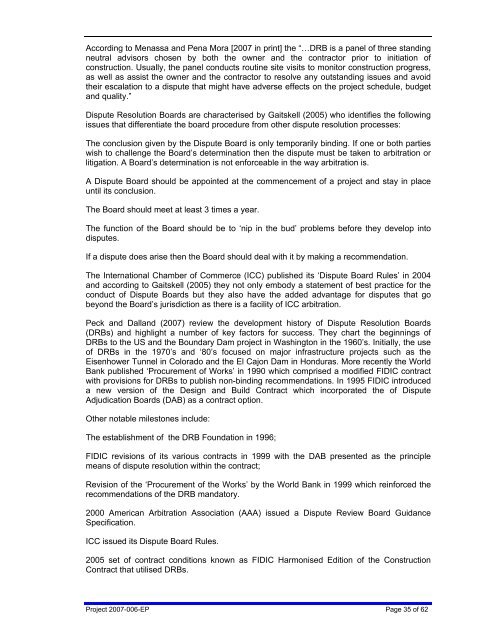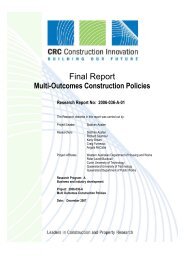Dispute Avoidance and Resolution (literature review) - Construction ...
Dispute Avoidance and Resolution (literature review) - Construction ...
Dispute Avoidance and Resolution (literature review) - Construction ...
You also want an ePaper? Increase the reach of your titles
YUMPU automatically turns print PDFs into web optimized ePapers that Google loves.
According to Menassa <strong>and</strong> Pena Mora [2007 in print] the “…DRB is a panel of three st<strong>and</strong>ingneutral advisors chosen by both the owner <strong>and</strong> the contractor prior to initiation ofconstruction. Usually, the panel conducts routine site visits to monitor construction progress,as well as assist the owner <strong>and</strong> the contractor to resolve any outst<strong>and</strong>ing issues <strong>and</strong> avoidtheir escalation to a dispute that might have adverse effects on the project schedule, budget<strong>and</strong> quality.”<strong>Dispute</strong> <strong>Resolution</strong> Boards are characterised by Gaitskell (2005) who identifies the followingissues that differentiate the board procedure from other dispute resolution processes:The conclusion given by the <strong>Dispute</strong> Board is only temporarily binding. If one or both partieswish to challenge the Board’s determination then the dispute must be taken to arbitration orlitigation. A Board’s determination is not enforceable in the way arbitration is.A <strong>Dispute</strong> Board should be appointed at the commencement of a project <strong>and</strong> stay in placeuntil its conclusion.The Board should meet at least 3 times a year.The function of the Board should be to ‘nip in the bud’ problems before they develop intodisputes.If a dispute does arise then the Board should deal with it by making a recommendation.The International Chamber of Commerce (ICC) published its ‘<strong>Dispute</strong> Board Rules’ in 2004<strong>and</strong> according to Gaitskell (2005) they not only embody a statement of best practice for theconduct of <strong>Dispute</strong> Boards but they also have the added advantage for disputes that gobeyond the Board’s jurisdiction as there is a facility of ICC arbitration.Peck <strong>and</strong> Dall<strong>and</strong> (2007) <strong>review</strong> the development history of <strong>Dispute</strong> <strong>Resolution</strong> Boards(DRBs) <strong>and</strong> highlight a number of key factors for success. They chart the beginnings ofDRBs to the US <strong>and</strong> the Boundary Dam project in Washington in the 1960’s. Initially, the useof DRBs in the 1970’s <strong>and</strong> ‘80’s focused on major infrastructure projects such as theEisenhower Tunnel in Colorado <strong>and</strong> the El Cajon Dam in Honduras. More recently the WorldBank published ‘Procurement of Works’ in 1990 which comprised a modified FIDIC contractwith provisions for DRBs to publish non-binding recommendations. In 1995 FIDIC introduceda new version of the Design <strong>and</strong> Build Contract which incorporated the of <strong>Dispute</strong>Adjudication Boards (DAB) as a contract option.Other notable milestones include:The establishment of the DRB Foundation in 1996;FIDIC revisions of its various contracts in 1999 with the DAB presented as the principlemeans of dispute resolution within the contract;Revision of the ‘Procurement of the Works’ by the World Bank in 1999 which reinforced therecommendations of the DRB m<strong>and</strong>atory.2000 American Arbitration Association (AAA) issued a <strong>Dispute</strong> Review Board GuidanceSpecification.ICC issued its <strong>Dispute</strong> Board Rules.2005 set of contract conditions known as FIDIC Harmonised Edition of the <strong>Construction</strong>Contract that utilised DRBs.Project 2007-006-EP Page 35 of 62
















